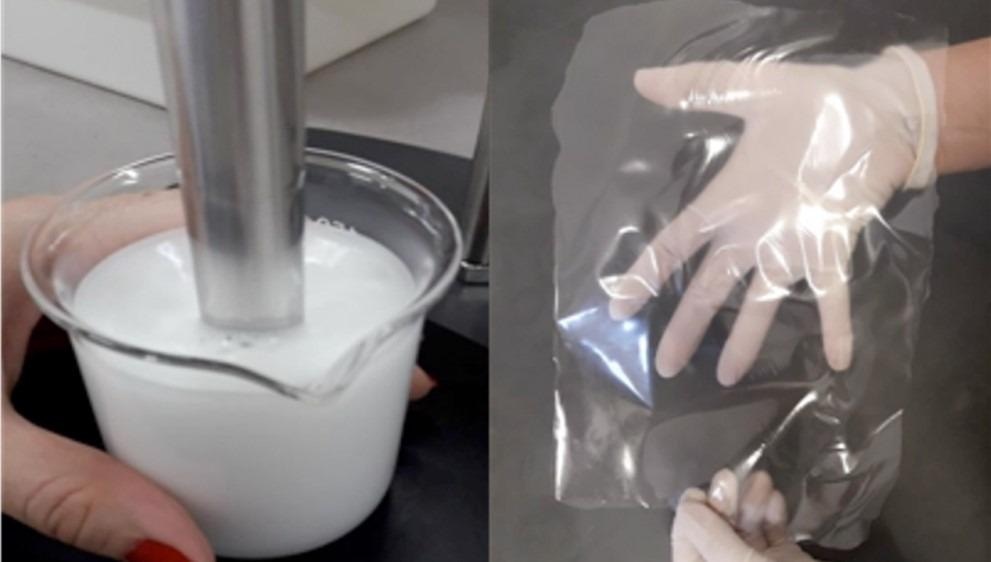The disposal of food packaging is a massive contributor to environmental pollution on a global scale. Over 350 million metric tons of plastic are generated yearly, and plastic forms 85% of the trash discarded in the oceans, according to reports.
 Designed for use as food packaging, the material is produced by scientists at São Paulo State University from gelatin, clay, and a nanoemulsion of black pepper essential oil (photos: preparing the mixture (left) and the gelatin-based biofilm. Image credit: researcher’s archive.
Designed for use as food packaging, the material is produced by scientists at São Paulo State University from gelatin, clay, and a nanoemulsion of black pepper essential oil (photos: preparing the mixture (left) and the gelatin-based biofilm. Image credit: researcher’s archive.
Brazil is ranked as the fourth-biggest producer of plastic, responsible for nearly 11 million metric tons annually. What is worse, the majority of plastic packaging is created from non-renewables like petroleum.
Given all these disadvantages, decreasing fossil fuel usage to create plastic is the goal of numerous studies worldwide. Many researchers are keen to create biodegradable packaging supplies that also avoid contamination by microorganisms and prolong life span so as to lessen losses.
Research carried out by a team referred to as the Composites and Hybrid Nanocomposites Group (GCNH) at São Paulo State University (UNESP) in Ilha Solteira has majorly contributed to resolving this issue. FAPESP supported the research, and an article presenting the study’s findings has been reported in the journal Polymers.
The scientists created their bioplastic (or “green plastic”, as it is also termed) from type B bovine gelatin procured from retail stores as a colorless powder without any difficulty.
Gelatin was one of the first materials used in the production of biopolymers. It’s still widely used owing to its abundance, low cost, and excellent film-forming properties.
Márcia Regina de Moura Aouada, Professor, Ilha Solteira School of Engineering (FEIS-UNESP)
Márcia Regina de Moura Aouada, a chemist and materials scientist, is the last author of the study.
“However, biopolymers for packaging have characteristics that need to be improved in order to be comparable to petroleum products, especially as far as mechanical properties and vapor permeability are concerned, so we added cloisite Na+ nanoclay to the gelatin,” she explained.
When nanoclay was added to the film, the film became more homogeneous and its tensile strength increased to 70 megapascals (MPa). In comparison, the tensile strength of traditional polyethylene packaging ranges between 20 MPa and 30 MPa, which is less than half.
Besides nanoclay, we also added a nanoemulsion made from black pepper essential oil to give the packaging a more attractive flavor and odor. The mixture also extends the shelf life of food products packaged with the material, thanks to the inclusion of anti-microbial and anti-oxidant components in the polymeric matrix.
Márcia Regina de Moura Aouada, Professor, Ilha Solteira School of Engineering (FEIS-UNESP)
Originally, the bioplastic was developed to package beef in the form of hamburgers, which are susceptible to contamination by microbes and have a strong odor, but the theory of integrating nanoclay and essential oil nanoemulsion to a gelatin matrix can and will be applied to other food items, differing in the type and proportion of essential oil employed.
“If this kind of packaging becomes widespread in the marketplace, it could significantly reduce the use of plastic made from non-biodegradable polymers and hence the amount of solid waste,” Moura Aouada said. “In addition, the bioplastic will better protect packaged food against contamination by pathogens and help reduce losses.”
The research direction pursued at GCNH-UNESP focuses on the circular economy, which turns waste into resources. The group’s leaders, Fauze Aouada and Márcia Moura Aouada, are professors affiliated with UNESP’s Program of Graduate Studies in Materials Science (PPGCM).
Our proposals are aligned with the Sustainable Development Goals [SDGs] adopted by the United Nations to end poverty, foster the planet’s economic sustainability, and ensure that the entire world population can enjoy peace and prosperity.
Márcia Regina de Moura Aouada, Professor, Ilha Solteira School of Engineering (FEIS-UNESP)
The group also develops edible packaging containing nanostructures extracted from cocoa purée, kale purée, camu camu (Myrciaria dubia) extract, cupuassu (Theobroma grandiflorum) purée, and nanoemulsions, as well as wound dressings from bacterial cellulose with possible applications in the food, cosmetics and pharmaceutical sectors.
The study is aided by FAPESP via a Research Regular Grant and also via the Center for Development of Functional Materials (CDMF), a Research, Innovation, and Dissemination Center (RIDC) hosted by the Federal University of São Carlos (UFSCar).
The study is multidisciplinary and requires networking with several scientists per topic. The article previously stated that Fauze Aouada, Tascila Saranti (MSc), and Pamela Melo (Ph.D.) from UNESP; and Miguel Cerqueira, from International Iberian Nanotechnology Laboratory, Portugal, were also co-authors of the study.
Journal Reference:
da S. Saranti, T.F., et al. (2021) Performance of gelatin films reinforced with cloisite Na+ and black pepper essential oil loaded nanoemulsion. Polymers. doi.org/10.3390/polym13244298.